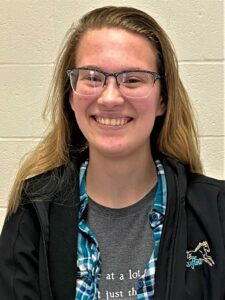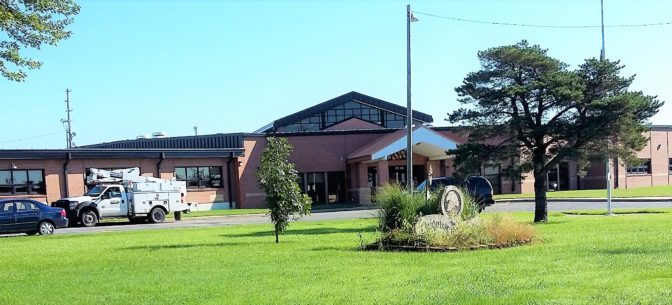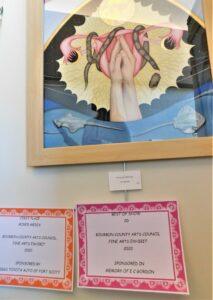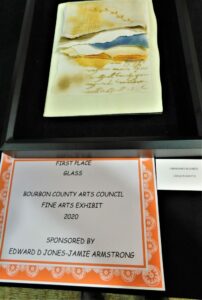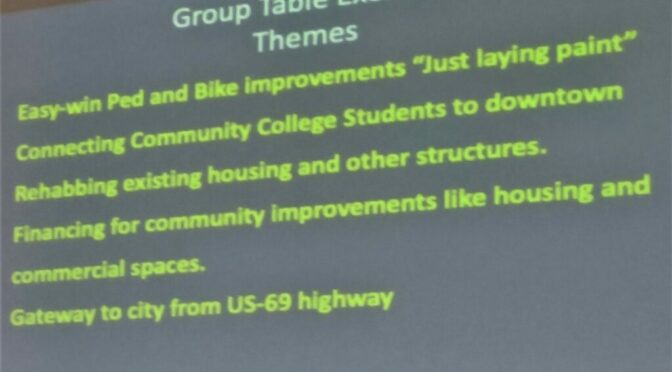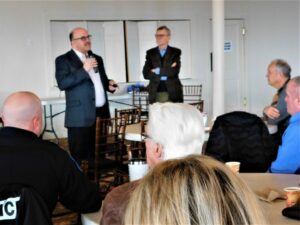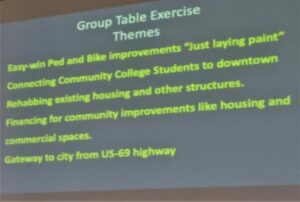February 11, 2020 Tuesday 1:30 pm
The Bourbon County Commission met in open session with all three Commissioners, the County Counselor and the County Clerk present.
Jeff Spangler with Crawford County, Tammy Helm with the Fort Scott Tribune, Hubert Thomas, Anne Dare, Barbara Peine, Kim Simons, Tim Emmerson, Mike Wunderly, Nancy Van Etten, Mark McCoy and Sparky were also present for a portion of the meeting prior to lunch.
Jim Harris and Jerad Heckman met with the Commissioners; Nick made a motion to approve a utility permit for CrawKan to install fiber near the Bourbon Allen Lake, Jeff seconded and all approved and signed the permit.
Jim Harris presented the Commissioners with the 2020 annual report of State funds available for Bourbon County which is $92,026.07, which is down from what the County received in 2019.
Jim Harris presented quotes for a mowing tractor; Heritage Tractor in Pittsburg quoted $61,750 (with $7,500 trade in) for a 6105E cab tractor, R&R in Fort Scott quoted $60,000 (with trade in) for a TS6.110. Jim said this tractor would complete the fleet, but he doesn’t have anyone to operate the tractor. No decision was made on the tractor.
Jim said they are crushing and hauling rock out of the Thomas Quarry; Jim said they have a supply of rock at the Beth Quarry, but said the supply would empty quickly. Nick questioned if the County needed the belly dump trucks; Lynne and Jeff thought they did. There was a discussion over producing more gravel; Hubert Thomas said he knew the County would never do rock quarries like they needed to do. He said they go from quarry to quarry hauling rock, he said if they didn’t run trucks all around the County to haul gravel they could help pay for another crusher. The Commissioners said they would have to figure out how to finance this since they are capped on their budgets; Hubert questioned if the payment would be similar if they traded in the current crusher. Lynne said when the current crusher was purchased they purchased too small of a crusher. Lynne and Nick asked Jim to get quotes for a lease purchase of a larger crusher; Jim said a crusher should last 40-50 years, it would be portable and could more than double their current rock production allowing them to stockpile at each quarry. This could cut fuel cost and eliminate some of the wear and tear on the vehicles hauling the gravel.
Jim said they have been hauling gravel around the County.
Jeff received a call regarding the roads in his district; he said they were complimentary of the road grader there and realized the road conditions were likely due to the weather conditions; the caller suggested coming up with a strategy of getting the roads back in good shape by prioritizing the bus route roads; Jim Harris said that is how they prioritize them now.
Hubert Thomas said he had heard there were bridges to be closed or condemned; Lynne said there are 35 bridges on the list to be closed and 12 to be rehabbed (all are over 20 foot and are not low water crossings). Mr. Thomas asked how much money was in the bridge fund; Jim Harris reported approximately $200,000 in the Special Bridge fund. Mr. Thomas asked why and when they did away with the bridge fund; the Commissioners said this was done a long time ago. They discussed the cost of bridge repairs; Jim Harris said the cost to install 3-18” pipes on Grand Road to open the road cost $25,000-$30,000. Lynne said they know they need a fund for bridges, he said they have done some of the repairs but haven’t kept up the needed repairs due to the lack of funding; Mr. Thomas said not to tell him they don’t have the money, since there is $70,000 – $100,000 that is being used for economic development that they could be using. He asked why we needed an event center in Bourbon County when we can’t take care of bridges and roads; he said the bridges should have been a concern a long time ago. Jeff said he planned to look at each bridge and if a bridge failed what could be done to restore. Mr. Thomas asked if a bridge is condemned how long before it would be closed; Justin Meeks said it’s the Road & Bridge director’s responsibility to bring the road and bridge issues to the Commissioners; Jim Harris said if it’s his responsibility he would be closing 35 bridges tomorrow. Jim said they need to have a work session to discuss the bridges. There was a brief discussion over bridges posted with no oversized loads and how that law is enforced. Mr. Thomas said he fell through a bridge (elsewhere) one time and was initially told he would have to pay for the bridge, but the State said it was a condemned bridge so he didn’t have to pay for the bridge. Mr. Thomas said a lot of people are upset over the economic development raise that was given; he said he read about lowering the taxes in Bourbon County, he said he felt that was never going to happen.
Jim said an area at 250th & Deer Road needs 6 8’ tubes, but they need 100 foot of roadway to install which they do not have.
Lynne reported asked Jim to clean out a low water crossing at 115th & Poplar. Jeff reported that 1 ½ miles west of Highway 7 on Wagon Road needs rock; Jim said they put rock there yesterday, but he would look at the road. Lynne discussed the 1cent sales tax; he said in 2020 it is up for renewal and said if it doesn’t pass it could dramatically affect all of the roads in Bourbon County. Jim said if it doesn’t pass he could lose 50% of his workforce. Jim suggested pledging some of the 1 cent sales tax for bridges, he said if this doesn’t pass the hard surface roads would deteriorate and eventually be gravel roads.
Jim said a motor grader needed $8,000 worth of tires if they were keeping it; Lynne suggested waiting to make a decision on the motor grader until Terry Sercer presents the final 2019 budget numbers.
Anne Dare discussed the roads to be used for the wind farms; Lynne discussed the road use agreements and said that the company will review the roads to be used and the company will make the necessary improvements for use and will leave the roads in better condition than they started with. He said they will purchase the rock and said they County will not provide the rock. Barbara Peine asked about the equipment clearing the trees on the highways; the Commissioners said that is State property.
Lynne made a motion to go into a 5 minute executive session for consultation with an attorney for the body or agency which would be deemed privileged in the attorney-client relationship, Nick seconded and all approved, (the session included the Commissioners and Justin Meeks). No action was taken.
Robert Uhler and Susan Bancroft with the City of Fort Scott met with the Commissioners to discuss the OMNI EMS billing; Susan reported the 2019 revenue received as $820,167.58 and fees received as $39,586.51, late fees $192.28 with $312558.00 outstanding as of 12/31/2019. She said the cash carryover for 2019 is $180,018.82; there was a discussion over using this towards a new ambulance chassis
in 2020.
Jordan Nielsen filmed the wind farm discussion.
Mary Pemberton met with the Commissioners; she presented the following information…Handout #1 “Over the past two weeks I have spoken with a large number of Bourbon County residents, some of whom support the Jayhawk Wind project and some of whom are opposed to it. I’d like to share two issues that are of overwhelming concern for residents. First, every person, and I mean without exception EVERYONE, believes our commissioners need to negotiate with Apex Clean Energy to receive payments that are in line with what Neosho County received when they signed agreements with Apex in June 2019.
Based upon the feedback I received, on behalf of residents of Bourbon County I am submitting to you the following list of terms that we would like to be certain are included in the various agreements that you sign with Apex. This is not intended to be an all-inclusive list; it is a list of what we feel are the “most important, must have” items. Nor is it meant to be written in contract language; it is written in a format to convey the intent of each requested item. Where amounts are shown, the number reflects the desired final result, not the start of negotiations. This list does not convey the preferences of any single person (myself included), rather it is a consensus and median of opinions. We ask that you please refer to this list of provisions when negotiating with Apex and take the necessary measures to ensure that each item is included, as closely to the stated amounts as possible, in the agreements prior to signing them.
***** Begin List of Agreement Provisions *****
A) Contribution Agreement:
1) Within 60 days after receiving the notice to proceed with the Jayhawk Wind project, the Developer shall make a one-time payment to the following entities and in the following amounts (this is in addition to any and all other payments).
$350,000 to the Bourbon County Road & Bridge Department
$75,000 to the Bourbon County Rural Fire Department
$100,000 to the City of Uniontown
$50,000 to the Redfield Sewer Utilities
$50,000 to the City of Bronson
2) Developer or Current Owner of the Jayhawk Wind project shall make annual contributions “PILOT” as shown below, payable to Bourbon County, Kansas.
Payments are due on MM/DD each year, beginning the first due date following project completion. These payments will continue annually until 10 payments have been made.
An amount equal to $3,350 per MW capacity located in Bourbon County.
3) Beginning in year 11 and continuing until decommissioning is completed, Developer or Current Owner will pay personal property taxes, i.e. “ad valorem tax”, in the amount normally assessed under Kansas statute. If for any reason personal property taxes are not assessed in any given year, an “Extended PILOT Payment” will be made. These Extended PILOT Payments will be an annual amount equal to $4,880 per MW capacity for the first Extended PILOT Payment and will increase by 1.5% per year thereafter.
B) Decommissioning Agreement:
1) The Developer or Current Owner shall dismantle and remove from the site all structures and equipment (above ground and to a depth of 4’ below grade) within 12 months of the abandonment or end of useful life of a turbine. Following removal, the area is to be refilled with soil of a reasonably similar quality and fertility to the original excavation. Access roads shall be removed in accordance with the terms of the property owner’s lease agreements.
2) A turbine shall be deemed abandoned or at end of useful life if it completes an 8 month period where no electricity is generated for distribution and there has been no plan submitted to Bourbon County Commissioners to restore the equipment to operating condition.
3) Within 30 days of completion of construction of the Project, the Developer or Current Owner shall establish an Escrow Account in the name of Bourbon County, Kansas “Decommissioning Fund”. The deposit made to establish this fund will be considered Year 1 and the month/day of this deposit will be the due date for all subsequent payments. Annual deposit amounts are as follows:
Years 1-5 = $7,500 per turbine
Years 6-10 = $10,000 per turbine
Years 11-15 = $15,000 per turbine
Years 16-25 = $20,000 per turbine
Following the year 15 deposit, the Escrow Account balance will be evaluated by Bourbon County Commissioners and Developer or Current Owner and if it is determined the balance will not be adequate for removal then additional financial security in the form of a performance bond or other approved security agreement will be required.
General Agreement regarding Wind Project and Transmission Facilities:
1) Sound Restrictions: Sound emanating from any turbine must be less than 45 dBA Leq as measured at the nearest exterior point of a non-participating habitable residential dwelling in existence on the date of this agreement.
2) Setback Requirements for residential dwellings: Turbines must be located at least 2000 feet from any non-participating habitable residential dwelling, as measured from the center of the base of the turbine to the center of the residential dwelling.
3) Setback Requirements for property lines: Turbines must be located at least 1000 feet from the property line of a non-participating landowner and/or the edge of any County right of way or County/State road. In the event property line setbacks conflict with residential dwelling setbacks, the dwelling setback requirements will prevail.
4) Setback Requirements for Public Lakes: Turbines must be located at least three miles from any public owned lake in existence on the date of this agreement.
5) Lighting: There shall be no lights on the towers other than those required by the Federal Aviation Administration.
6) Turbine Tower Design: Turbine towers shall be painted a non-reflective white or pale gray. To promote visual uniformity, the rotors, nacelles and towers in the array should be identical in appearance. No logos or advertisements are allowed on the structures. Each turbine shall be marked with a visible identification number located no higher than 15 feet above ground level.
7) Shadow Flicker: Developer shall design the Wind Project in a manner that limits the visibility of shadow flicker to a duration not to exceed a cumulative 45 hours per year at any non-participating residential dwelling.
8) Electromagnetic and Reception: Interference surveyed and mitigation actions taken.
9) Communication and Power Collection Lines: Communication lines and power collection lines are to be installed underground wherever feasible and shall at all times be installed so as to not interfere with agricultural usage or other current usage of the property.
10) Topographical Map: At least 45 days prior to commencement of any construction activities, Developer shall provide to Bourbon County Commissioners a USGS 1:2000 scale map. The following features must be identified, included and labeled on the map for the entire proposed Wind Project area plus an additional one mile beyond the Project area:
a) Lot lines for each parcel under separate ownership. A key identifying the owner of each parcel, by owner name and CAMA parcel number, must be included.
b) All residential dwellings and other large structures such as barns.
c) All public roads and access roads.
d) Utility lines and pipelines currently in existence.
e) Location of all Turbines, Transformers, Substations, Connecting Power Lines and Other Structures to be erected and used as part of the operation of the Project. If there are any changes in location of these structures, the County must be notified prior to construction and a revised map provided to the County upon approval of the changes and prior to any commencement of construction.
11) Prior to commencement of construction, Developer shall provide a Fire Safety and Emergency Plan to the County Commissioners which identifies the potential fire risk associated with the project, including prescribed and non-prescribed burning. This shall address fire originating within the site, fires escaping from the site and potential effects of fire originating from outside the site. The Developer or Current Owner shall provide 24-hour contact information to the Bourbon County Emergency Management Department and shall post emergency contact information on site; any time this contact information changes and updated notice must be posted and provided at least 1 day in advance of changes. This Plan shall also address high angle rescue and all provisions for fire suppression, fire and emergency medical response both during construction and operation of the Project. The Plan shall identify what equipment is not presently owned by the Rural Fire Department or other first responders located within Bourbon County, which may be needed to respond to emergencies at the Project site. Any equipment so identified must be purchased or provided by Developer.
12) In the event of an extraordinary event, such as tower collapse, turbine failure, broken/thrown blade or collector-feeder line failure, the Developer or Current Owner must notify the Bourbon County Emergency Management Department within 15 minutes of discovery of the event.
13) Prior to commencement of construction, the Developer must provide evidence that they have successfully entered into an agreement for the off-site purchase of power produced by the Project.
14) Developer or Current Owner must notify Bourbon County Commissioners at least 30 days prior to transferring any ownership, power purchase agreements, or other interest in the Project to another party. The new party must be informed of all agreements made between the Developer and Commissioners and must provide Commissioners with a written “acknowledgement and agreement to comply” with all provisions of such agreements.
15) Proof of Insurance and Hold Harmless for construction and operation phases provided to County in adequate amounts including: Liability, Auto, Worker’s Compensation, Umbrella Excess Liability.
C) Road Usage Agreement:
1) Developer shall include a plan to control dust on roads which will be used during construction.
2) Commissioners must approve the Subcontractor hired to perform road improvements and maintenance
during the construction phase.
***** End List of Agreement Provisions *****
The second predominant concern I heard when talking with people in Bourbon County is “how is the PILOT money going to be spent” and “they better make sure it reduces our taxes and not spend it all on raises and economic development”. To address this concern and help promote goodwill between residents and county government we ask that Commissioners to do one of two options:
1) Conduct a survey of at least 10% of residents, to determine preferences on specific spending options, and use the survey results to determine how proceeds will be used.
2) Allocate the PILOT proceeds to the various taxing entities as if they were normal property tax revenue.
Once it has been determined, pass a resolution indicating how the PILOT proceeds are to be allocated and used. This resolution should be published along with a projection of how the PILOT proceeds, when used as specified in the resolution, will impact property taxes over the ten year period.
Thank you for your time, thoughtful consideration of these concerns, and implementation of these recommendations on behalf of Bourbon County residents.
Handout #2
By now I would hope you all realize that I have never suggested the County Commissioners block the Jayhawk Wind project from proceeding nor have I suggested the Commissioners interfere with the rights of a landowner to sign a lease agreement. My intent and goal always has been and continues to be to help educate you on the issues and ensure that Bourbon County realizes agreements that are favorable to ALL of the residents of the county.
It is clear under Kansas statutes that County Commissioners are charged with negotiating and signing contracts/agreements and that they are required to perform certain duties:
KS Stat 19-212, Powers of board of commissioners – relevant paragraphs from this statue include: 6) “To represent the county and have the care of the county property, and the management of the business and concerns of the county, in all cases where no other provision is made by law.” and 11) “To contract for the protection and promotion of the public health and welfare.”
KS Stat 19-243 Violation of 19-241, 19-242 or failure to perform duties; penalty “Any board of county commissioners, or any county commissioner, or county clerk, who shall violate any of the provisions of this act, or neglect or refuse to perform any duty herein imposed, shall be deemed guilty of a misdemeanor, and upon conviction thereof in a court of competent jurisdiction shall be subject to a fine of not less than ten dollars nor more than ten thousand dollars, and shall, moreover, be removed from office.”
It is also clear that the county is both immune from and open to certain liabilities.
Under the Public Duty Doctrine a plaintiff suing a governmental entity in negligence cannot establish the duty element for a claim when the duty is a public one, i.e., owed to the public at large and not to any particular individual (Keiswetter v State, 2016). Also, liability under K.S.A. 75-6103(a) exists only if a private person would also be liable under Kansas law.
Kansas Tort Claims Act K.S.A. 75-6101 – 75-6120 (this statute provides 24 areas of immunity to governmental entities, plus a catch-all provision – some of these areas are detailed below).
Legislative Function, K.S.A. 75-6104(a) – A governmental entity or an employee acting within the scope of the employee’s employment shall not be liable for damages resulting from: (a) Legislative functions, including, but not limited to, the adoption or failure to adopt any statute, regulation, ordinance or resolution.
Discretionary Function, K.S.A. 75-6104(e) – A governmental entity or an employee acting within the scope of the employee’s employment shall not be liable for damages resulting from: (e) any claim based upon the exercise or performance or the failure to exercise or perform a discretionary function or duty on the part of a governmental entity or employee, whether or not the discretion is abused and regardless of the level of discretion involved.
Indemnity for Punitive Damages:
1) A government entity is not liable for punitive damages (state or federal claims).
K.S.A. 75-6105(c), City of Newport v Fact Concerts Inc
2) Employees are not liable for punitive damages (for state law claims under KTCA) except for fraud or malice. K.S.A. 75-6105(c), Alden v Maine
No Constitutional Claims under KTCA:
1) The KTCA creates no new causes of action beyond what is already available under Kansas law, and there can be no greater liability under the KTCA than a private person would have under Kansas law.
2) The KTCA provides only for liability where the governmental entity, if a private person, would be liable under the laws of this state. Because there is no statutory or common-law cause of action in Kansas by which a private person may be liable for damages for deprivation of a person’s constitutional rights, neither the State nor its employee could be liable for the plaintiff’s First Amendment claims under the KTCA.
I am assuming that each of you can read and understand the above citations so I won’t explain in detail. However, I would like to point out a few particulars, as they relate to your role concerning the Jayhawk Wind project.
1) County Commissioners have a duty to negotiate the various agreements before signing them. This isn’t limited to only the road usage agreement, it means ALL of the agreements. This duty is not restricted because Bourbon County is not zoned. These agreements have nothing to do with zoning, they have all to do with your assigned task of entering into agreements on behalf of the citizens of Bourbon County.
2) One of your specific duties, important enough to be dictated by state statute, is to contract for the protection and promotion of the public health and welfare. You are neglecting your duty if you do not negotiate contract provisions which protect the people of Bourbon County, including things such as reasonable setback requirements, ensuring adequate decommissioning, and financial payments.
3) Your duties as Commissioners (and Counselor) are to ALL the citizens of Bourbon County – i.e. the public at large, not to any particular individual(s).
4) The ability of one particular landowner to successfully sue the county for causing a delay (or even preventing) the Wind project from proceeding is extremely slim for a number of reasons, most notably: a government entity is exempt from punitive damages; liability exists only if a private person would be liable (which in this case they would not); and government employees are exempt from liability arising from the performance of their duties. Therefore, you should worry less about potential liability resulting from action that the county is, by law, immune from and worry more about potential liability resulting from neglecting your duties to ALL citizens of the county.
5) As far as concern over the Wind project developer suing the county, that is another unfounded concern. The developer knows from day 1 that there are certain steps to follow, approvals to obtain and agreements to sign. They do not reasonably expect you to sign the first proposed agreement they present, without multiple sessions of review, discussion and negotiation. They have built in a time allowance for this all to occur – you are not delaying the project in any way by taking a couple of months to negotiate contracts. Will they try to push you to sign quickly? Of course – because they know that gives you less time to do your homework and makes you more likely to sign agreements that are heavily weighted in their favor, at the expense of Bourbon County citizens.
To summarize once again, you each have a duty to enter into agreements that provide the best possible outcome for the citizens of Bourbon County and this means negotiating terms on each and every agreement prior to signing. State statute requires it and the citizens of the county deserve and expect it. I’ll go so far as to state that it would be in the best interests of Bourbon County to hire an attorney who specializes in contract law to negotiate these agreements for you. Apex has an attorney who specializes in wind energy contracts; Bourbon County should be represented by an attorney who specializes in contracts. These agreements have too major of an impact on everyone in the county for at least the next 25 years to rely solely upon the county counselor.”
Lynne said the County had been in negotiations with Jayhawk and said they can’t discuss what is in the contract. Lynne said there are multiple road accesses (on the State highway) Jayhawk could use and said they could come into our County without the road use agreements. Lynne said the PILOT agreement is a voluntary agreement. Jeff said he had seen a boundary map and the roads they might be using, he said it will be on the agenda when they plan to sign the agreement and said when they sign them it will be in open session. Mary Pemberton discussed the PILOT money; she said the money better not be spent on raises and economic development, she suggested passing a resolution to provide the public with the intent of where the PILOT funds would be spent. The PILOT agreement is a contract with a delinquency clause in it. Tim Emmerson suggested the County adopt a resolution prior to any agreements being signed to establish setbacks and set height limits for future projects. Barbara Peine suggested the County establish a zoning resolution to restrict and stop the future building of any other wind turbine projects. FAA guidelines were discussed; Sparky said that those guidelines are already established and the wind farm company will have to meet those standards. The Commissioners said prior to the wind farm it had been a long time since someone had approached them about investing hundreds of millions of dollars in our community.
Lynne made a motion to go into a 7 minute executive session for consultation with an attorney for the body or agency which would be deemed privileged in the attorney-client relationship, Nick seconded and all approved, (the session included the Commissioners and Justin Meeks). After the session, Nick made a motion to allow Justin Meeks to sign a document saying he verified that $3,579 was spent by Fire District #5 for their insurance premiums, Jeff seconded and all approved.
Justin informed the Commissioners that he might be asking for a special meeting to discuss the land bank.
Nick made a motion to go into a 5 minute executive session for personnel matters of individual non-elected personnel, Jeff seconded and all approved, (the session included the Commissioners, Ben Cole, Bill Martin and Kendell Mason). No action was taken.
Nick made a motion to go into a 5 minute executive session for personnel matters of individual non-elected personnel, Jeff seconded and all approved, (the session included the Commissioners, Ben Cole, Bill Martin and Kendell Mason). After the session, Nick made a motion to allow Bill to move a part time employee to a full time temporary position until further notice, Jeff seconded and all approved.
At 4:12, Nick made a motion to break for dinner and reconvene at the Ellis at 5:30 to meet the attendees of the 6:00 meeting, Jeff seconded and all approved.
At 6:00 pm the Commissioners held a wind farm meeting; several people attended the meeting along with Jayhawk Apex representatives Juliana Planelli (2 years with APEX), Chris Rutherford (6 years with APEX, Bourbon County is his 10th project), Scott Koziar (12 years with APEX), Helen Humphries, as well as Alan Anderson and attorney with Polsinelli. Mrs. Planelli said the wind farm being built is a 195 megawatt project; she said they had been developing the project since 2017. She said the construction of the wind farm in the southwest corner of Bourbon County will start in the fall of 2020 and be operational in 2021. The northwest to southeast project will use the Evergy transmission line. The project is 8 miles west to east and 11 miles north to south. The following questions previously asked at another wind farm meeting were discussed; it was asked if there could be a onetime window releasing a landowner from a signed lease; Mrs. Planelli said no since they are spending millions of dollars of the project and need certainty about the leased land. She said the leases do not run forever, she said a turbines lifespan is 25-30 years and said some of the projects are repowered and said at the end of their lifecycle it would be up to the project owner and the participant to enter a separate agreement if repowered. She said at the end of the lifecycle the term of the lease is no longer in effect. It was previously stated that the money from the turbines will go to Germany; Mrs. Planelli said they are a West Virginia based company and said they will operate some of their wind farms and some farms will be operated by others. The PILOT agreement (a legally binding agreement) was discussed; she said it is a 10 year contribution (from the first year operational to year 10, the project is abated from taxes for 10 years) agreement and it is up to the County’s discretion to decide where to use the funds. At year 11 the project will be on the tax rolls and it would be up to the taxing jurisdiction at that point. It was asked if this 10 year abatement could be extended; they said no. Mrs. Planelli said the PILOT could help reduce the taxes or the PILOT money could be used to upgrade schools or projects, (whatever the County decides to do with the PILOT money). It was previously stated that wind turbines affect medical devices; she said they have 57,000 turbines in the U.S. and know of no reports of the effects on medical devices. A question was asked of what remains of the wind farm when the project is concluded and not repowered; she said they are decommissioned 48” below the earth and the property is put back to its pre-existing condition. She said in the event that the wind farm owner is not able to decommission the project; a bond is put in place to pay the funds to decommission the project. She said part of the agreement with the County will have a bond in place for decommissioning. The impact on the community was discussed; she said there will be a financial impact with the revenue from the construction. She said they will educate the landowners. Chris Rutherford discussed the impact on the local roads; he said during the general construction they will be bringing in proponents, he said the road use agreement will define the only roads they will use. He said they will upgrade the roads as needed for their use and will maintain those roads. He said they will coordinate with the school buses. They will pay for the cost of doing the necessary road upgrades prior to use and will maintain them. A map of the roads they may use was presented; Mrs. Planelli said they will flag and shut down the roads when needed; she said safety is a core focus of their company. It was questioned if the wind farm will shut down when the subsidies run out; Scott Koziar said no, he said they are typically financed for a 25-30 year period. He said for the first 10 years the company that owns the wind farm will use a PTC (production tax credit) to lower their tax liability. It was asked if the company could come into our county without a road use agreement; they can, but do not want to do that, all of their projects have had a road use agreement in place. It was previously stated that property values decline due to the presence of wind farms; Mrs. Planelli said in Kansas studies have been done and concluded that wind farms don’t impact property values. It was asked how they can say that the Counties aren’t loosing value due to the wind farms; Mr. Anderson said Kansas assessors are saying that hasn’t happened. Mrs. Planelli said County appraisers and assessors said that on average they have a neutral impact and said if property values decline that wind farms are not the sole driver and said there are other factors. They agreed to provide the studies on property values. Mr. Koziar discussed the leased land being used for collateral; he said if there is a mortgage on the leased land and the land is foreclosed on the bank could cancel the lease on the property. He said if the land goes into foreclosure they could work with the landowner and the bank to continue to operate the wind farm. He said some landowners see leasing the land to them as a revenue stream to pay the loan on the property off. Mr. Rutherford discussed decommissioning a wind farm; he said the 3 or 4 steel tubes are recycled, the generator is recycled, the blades and body are fiberglass and are taken down and shipped to factories to be recycled. Endangered species, Eagles and birds and bats flight patterns were discussed; APEX has contacted and works with KDWP. It was asked if the deer and game population would be hurt; they said they will ask the environmental manger that question. APEX does an archeological assessment with their projects. It was asked if the builders of the project bring campers to live in or live in hotels; they said there will be approximately 200 employees and they will do both as well as some will rent homes since they will be here approximately 1 year. Long term there will be 10-16 full time maintenance positions. The energy produced from the wind turbines will be put on the grid with all of the other energy produced. It was asked if having the wind farms here would reduce electric bills; there is no guarantee of this, but the cost of producing wind energy is cheaper than others. Utility companies are buying wind power energy because it is cheaper than other sources. APEX enforces respectful behavior of their employees. It was asked how tall the turbines would be; currently there is no set turbine height, but they anticipate them to be up to 600 feet. They will have blinking red lights on them due to FAA regulations. It was asked if they would affect life flight services; APEX works with emergency services so if they have an emergency they can be reached. The red lights are on them so they can be seen; the turbines can be turned off in an emergency to allow for life flight to land close to them. It was asked if they would still pursue the project if the construction was delayed until after the end of 2020; they said yes they would still this pursue since they have leased land. They have initiated the geotechnical work for the project. It was asked how close any of the representatives lived to a wind farm; none lived near, but one had family with a wind farm on their land. It was asked about the proximity to houses and buildings; this will be decided in the setback agreement. Jayhawk has approximately 20,000 acres leased for their project; they said if a lease holder passes away the lease runs with the property. It was asked if the landowner could terminate the lease; if the company wasn’t making the agreed payments to the landowner they could terminate the lease. The wind farm project does not have eminent domain. It was asked if they have gag orders regarding discussing leases; APEX said the lease is a private contract and they do not tell people to not talk about the lease, they said they encourage the neighbors to talk to each other. It was asked where they would get the rock for the project; they want a quarry as close as possible to the site. It was asked if they were going to fight paying taxes; the formula for calculating the taxes is set by the state. They factor in the positioning of the turbines to avoid the shadow flicker. It was asked when the County learned about a wind farm coming into the County; Jeff said this was discussed during a Commission meeting 2016. It was asked what other economical development projects there were if this project doesn’t come to Bourbon County; Jeff said he didn’t know of any other projects. Zoning was discussed; Jeff estimated it would cost $250,000-$300,000 to enforce/implement zoning. He said zoning shouldn’t be a reaction and said in California $100,000 worth of permit fees were charged to build a house. Jeff estimated the added value due to the wind farm could mean a possible 13-14% reduction in the tax levy. The Commissioners are still reviewing the agreements. Roger Kraft said he had asked questions that had not been answered; he hoped the Commissioners would do their due diligence regarding the wind farms. Marita Meech suggested the County hire a wind energy lawyer. She said the skyline would forever change with the presence of the wind farms. Ken Anderson said he wasn’t for or against this project, but said he has property in Cloud County with a wind farm on it (he worked with the APEX representatives when it was built); he said this has been there approximately 13 years. He said Cloud County gets a $350,000 PILOT payment. He said the roads there have improved, the wind company has been good neighbors and new houses are being built close to the towers. He said the college there put in wind powered education classes; and said graduates make $20-$25/hour. A bird study was done there for $250,000 and it showed there was no more impact on the birds than normal farm buildings have. He said there hasn’t been an impact on the prairie chickens and said the flock is growing. He said everyone in the wind project gets a piece of the pie. Jayhawk has opened a local office in Girard, Kansas.
The meeting adjourned at 7:45 pm.
THE BOARD OF COMMISSIONERS
OF BOURBON COUNTY, KANSAS
(ss) Lynne Oharah, Chairman
(ss) Jeff Fischer, Commissioner
(ss) Nick Ruhl, Commissioner
ATTEST:
Kendell Mason, Bourbon County Clerk
February 18, 2020, Approved Date
